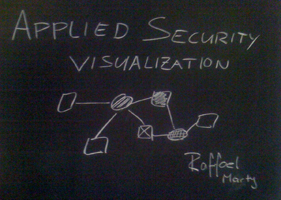
 As part of the ISSummit in Hong Kong, I will be teaching a one day workshop on security visualization. The following is the abstract of the training:
As part of the ISSummit in Hong Kong, I will be teaching a one day workshop on security visualization. The following is the abstract of the training:
As networks become ever more complex, securing them becomes more and more difficult. The solution is visualization. Using today's state-of-the-art data visualization techniques, you can gain a far deeper understanding of what's happening on your network right now. You can uncover hidden patterns of data, identify emerging vulnerabilities and attacks, and respond decisively with countermeasures that are far more likely to succeed than conventional methods. The attendees will get an overview of visualization, data sources for IT security, and learn how to generate visual representations of IT data. The training is filled with hands-on exercises.
The talk is going over the following individual topics:
- Section 1:Visualization
Visualization is the core topic of this training. The first section introduces some basic visualization concepts and graph design principles that help generate visually effective graphs. - Section 2:Data Sources
Visualization cannot exist without data. This section discusses a variety of data sources relevant to computer security. I show what type of data the various devices generate, show how to parse the data, and then discuss some of the problems associated with each of the data sources. - Section 3:Visually Representing Data
Data can be visualized in many different ways. This section takes a closer look at various forms of visualizations. It first discusses generic graph properties and how they can help encode information. It then delves into a discussion of specific visualizations, such as charts, box plots, parallel coordinates, links graphs, and treemaps. The section ends with a discussion of how to choose the right graph for the data visualization problem at hand. - Section 4: Data Visualization Tools
After a short introduction to different data formats used by visualization tools, this section then discusses visualization to
ols and libraries. Based on the Data Visualization and Analysis UNIX (DAVIX) distribution I show how simple it is to generate
visual representations of IT data. - Section 5: Perimeter Threat
This section is a collection of use-cases. It starts out with a discussion of use-cases involving traffic-flow analysis. Everything from detecting worms to isolating denial-of-service attacks and monitoring traffic-based policies is covered. The use-cases are then extended to firewall logs, where a large firewall ruleset is analyzed first. In a second part, firewall logs are used to assess the ruleset to find potential misconfigurations or security holes. Intrusion detection signature tuning is the next two use-case. The remainder of the section looks at application layer data. Email server logs are analyzed to find open relays and identify email-based attacks. The section closes with a discussion of visualizing vulnerability scan data.
Should you be in Hong Kong on November 20th, come check out the training. Should you miss it, I will be teaching a two day workshop at SourceBoston, Boston in March 2009.

